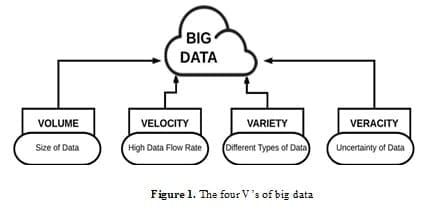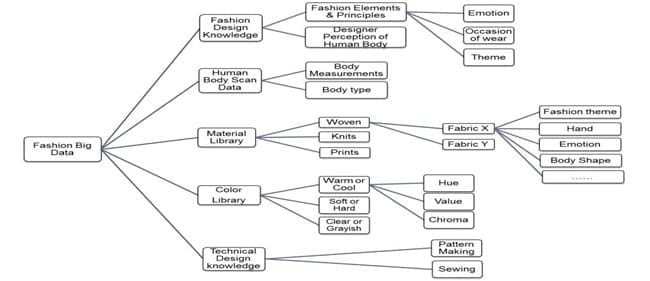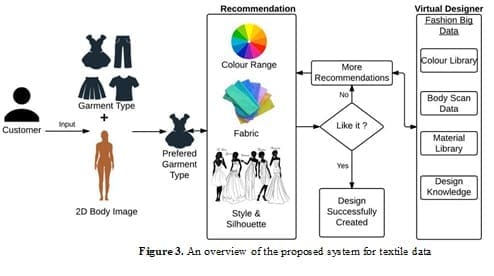Kanishk Barhanpurkar, Department of Computer Science, SAIT, Bengaluru, Karnataka, India Shyam Barhanpurkar, Department of Textile Technology, SVVV, Indore, MP state, India
Abstract
The concept of big data includes analyzing capacious data to extract valuable information. In the textile world, big data is increasingly playing a part in trend estimating, analyzing consumer performance, preference. The purpose of this paper is to introduce the term textile data and why it can be considered as big data. It also gives a broad classification of the types of textile data and briefly defines them. Also, the methodology and working of a system that will use this data is briefly described. Big data refers to a process that is used when traditional data mining and handling techniques cannot uncover the insights and meaning of the underlying data. Data that is unstructured or time sensitive or simply very large cannot be processed by relational database engines. This type of data requires a different processing approach called big data. This approach can be utilized for analyzing the information relating to spinning, weaving, chemical processing and in garment sector. This segment will definitely enhance the value addition in technological development and interpretate to solve the problems of the process. Even than very negligent researches are available in this field but it’s a lastly growing field and smartly ulilzed in the textile sector. In this research paper some information have been reviewed and tried to described for researchers and technologists.
Keywords: Big Data, Cyber Physical Systems(CPS), Digital Textile, Textile Data.
- Introduction
Modern manufacturing facilities are data-rich environments that support the transmission, sharing and analysis of information across ubiquitous networks to produce manufacturing intelligence. The potential benefits of manufacturing intelligence include improvements in operational efficiency, process innovation, and environmental impact, to name a few. However, similar to other industries and domains, the current information systems that support business and manufacturing intelligence are being tasked with the responsibility of storing increasingly large data sets (i.e. Big Data), as well as associate the real-time processing of this ‘Big Data’ using advanced analytics. The predicted exponential growth in data production will be a result of an increase in the number of instruments that record measurements from physical environments and processes, as well as an increase in the frequency at which these devices record and persists measurements. The technologies that transmit this raw data will include legacy automation and sensor networks, in addition to new and emerging paradigms, such as the Internet of Things (IoT) and Cyber Physical Systems (CPS) and Artificial Intelligence(AI). The low-level granular data captured by these technologies can be consumed by analytics and modelling applications to enable manufacturers to develop a better understanding of their activities and processes to derive insights that can improve existing operations. Big data, as the name suggests, is an enormous amount of data. It can be defined by the 4V’s – Volume, Velocity, Variety, and Veracity. This 4V’s are responsible for complete functioning and analysis of data to obtain required output. The ability to analyze this enormous amount of data is known as big data analytics. The analysis of big data makes valuable conclusions by converting the data into statistics, that otherwise could not be exposed using less data and old-style methods.
To deal with this, the industry has experienced a shift from mass production to mass customization, which is simply customization at mass production efficiency. There are many technologies that help the industry in creating new ways for satisfying the ever-growing and ever-changing needs of the customer. There are, however, many challenges when it comes to adapting the production process as complexity increases with the level of customization. Another problem with mass customization is that, the customer is unaware of her/his needs and mostly lack professional design knowledge. Due to this, most mass customized products are not as desired, and hence, the customer is rendered dissatisfied. Thus, the requirement of a personal style advisor arises; to help the customer in finding a garment that satisfies her/his needs. Since, everything is going on the web, so there are virtual style advisors available. Most of them are not affordable by every customer. For this, the recommendation systems were introduced. These systems offer the customer recommendations during the process of designing. They can be based on collaborative filtering, wherein the system recommends on the basis of the preferences of a group of users; content based filtering, wherein the system uses user profile to match an item. This requires ratings given to a product directly by the user.
2. Importance of Big Data
The importance of big data does not revolve around how much data a company has but how a company utilises the collected data. Every company uses data in its own way; the more efficiently a company uses its data, the more potential it has to grow. The company can take data from any source and analyse it to find answers which will enable:
i. Cost Savings: Some tools of Big Data like Hadoop and Cloud-Based Analytics can bring cost advantages to business when large amounts of data are to be stored and these tools also help in identifying more efficient ways of doing business.
ii. Time Reductions: The high speed of tools like Hadoop and in-memory analytics can easily identify new sources of data which helps businesses analyzing data immediately and make quick decisions based on the learnings.
iii. New Product Development: By knowing the trends of customer needs and satisfaction through analytics you can create products according to the wants of customers.
iv. Understand the market conditions: By analyzing big data you can get a better understanding of current market conditions. For example, by analyzing customers’ purchasing behaviors, a company can find out the products that are sold the most and produce products according to this trend. By this, it can get ahead of its competitors.
v. Control online reputation: Big data tools can do sentiment analysis. Therefore, you can get feedback about who is saying what about your company. If you want to monitor and improve the online presence of your business, then, big data tools can help in all this.
3. Textile big data
All the data associated with a textile product is hence called as textile data. This data can have used for trend analysis, customer behavior analysis, forecasting etc. Textile industry generates and creates various sources of data. All these data come in various forms like words, images etc. Since it is the era of fast textile, the data is rapidly growing and changing. Hence, this data can be termed as fabric big it portrays all the features of big data. Following is a broad classification of the textile data –
i. Material: This includes the fabric that is used to make a textile product. The fabric has various characteristics like yarn type, yarn count, yarn twist, weft & warp density, weave structure etc. To achieve different types of fabric, one or more of these are changed. This enormously changes the appearance and had of the fabric, which correlate to emotions, textile themes, colors etc.
ii. Textile Design: It is the knowledge about the elements & principles of design, which combined together, gives the design of a textile product. The design of a product is mostly influenced by human emotions, textile themes, occasion of wear etc.
iii. Body Data: The body data can be in the form 2D or 3D data. For 2D, it is collected using the conventional method of body measurement. For 3D, it is collected 3D body scanners. These data can provide information like body measurement & body type.
iv. Color: Color preference is an important aspect that influences a gamut of human behavior. Kobayashi’s color image scale states that color can have three attributes – warm or cool, soft or hard, clear or grayish, which associate with hue, chroma & value. These attributes can be linked with the emotion
v. Technical/Production design: The technical design allows the producer to understand that how the product will be made. This makes the design of a product production friendly. It includes knowledge of pattern making, sewing etc. To extract knowledge from these data, they have to be linked together. The next section describes the proposed system that will use this data.
Figure 2. Data in Textile
Proposed System
The proposed system (figure 3) is a combination of the knowledge based recommender system and a search engine. It takes from engine the ability to provide the customer with an option to write her/his query and with the help of the recommender system, offer a product to the customer. The system will have the knowledge bases mentioned in section 3. These bases will help in removing the cold start problem. The working of the system will be such that the customer can select a garment silhouette and provide his measurements, now the system will recommend a material, color, design which matches best the garment type selected as well as that looks best on the body type (to be identified using the measurements provided by the customer). If the customer likes the recommendations she/he can choose to order the garment, or else the system will improve its suggestions. The methodology to be followed to build the system is also presented in figure 3. In this methodology an algorithm has been designed in such a way that on inputting the customer requirements such as garment type and 2D body image about the preferred product on which provides recommendation about color range, fabric and style format. Afterwards, a virtual designer on basis on big data applications it will show other functionalities which are related to body scan, design knowledge etc. If the conditions are fulfilled the new design will create successfully. In this way methodology will work.
Goal of Big Data Tools:
Big Data tools are used for the analysis of the huge and complex data. Many organizations have now taken Big Data not just a buzz-word but a new technique for improving business. Organizations have to analyze mixed structured, semi structured or unstructured data. This is dons in search of useful business and market information and insights. Big data analytics helps organize this data for the organizations. Organizations have to analyze mixed structured, semi structured or unstructured data. This is dons in search of useful business and market information and insights. Big data analytics helps organize this data for the organizations. Big data analytics is the process of examining large data sets containing a variety of data types — i.e., big data to uncover hidden patterns, unknown correlations, market trends, customer preferences and other useful business information. The analytical findings can lead to more effective marketing, new revenue opportunities, better customer service, improved operational efficiency, competitive advantages over rival organizations and other business benefits.
Conclusion
The study introduces the term textile data and why it can be termed as big data. It also presents the classification of the data and briefly defines each one of them. In addition to this, a system is proposed that will use this data to provide the customer with a mass customization service. This methodology and working of the proposed system is briefly described. The future work involves the collection of the textile data, creating knowledge bases, establishing a link between those knowledge bases and connection it to the search engine.
Future Scope
Besides textile industry people, technology vendors are playing significant role in transforming the digital textile industry. Leaving behind popular social media forums, firms like SAP offer high-speed analytical tools which allow you to turn good volume of data into real business value, in just a blink of an eye. Big Data Analytics of textile product suppliers can also be leveraged to have good understanding on trends and ideas, which are persisting among audience, and those which are on the verge of being forgotten. Using such insights, designers make necessary adjustments in their products, change their marketing strategies, and then launch their fine collections in the market. Thus, Big Data influences key decisions related to manufacturing textile products, and helps both the industry leaders and their targets to know each other, and jointly cooperate in taking the digital textile industry accelerative.
References
[1] De Raeve A, De Smedt M, Bossaer H. Mass customization, business model for the future of fashion industry. In 3rd Global Fashion International Conference 2012 Nov (pp. 1-17).
[2] Sharma R, Singh R. Evolution of recommender systems from ancient times to modern era: A survey. Indian Journal of Science and Technology. 2016 May 30;9(20).
[3] Park DH, Kim HK, Choi IY, Kim JK. A literature reviews and classification of recommender systems research. Expert Systems with Applications. 2012 Sep 1;39(11):10059-72.
[4] Guan C, Guan C, Qin S, Qin S, Ling W, Ling W, Ding G, Ding G. Apparel recommendation system evolution: an empirical review. International Journal of Clothing Science and Technology. 2016 Nov 7;28(6):854-79.
[5] Kyu Park C, Hoon Lee D, Jin Kang T. Knowledge-based construction of a garment manufacturing expert system. International Journal of Clothing Science and Technology. 1996 Dec 1;8(5):11-28.
[6] Martínez L, Pérez LG, Barranco MJ, Espinilla M. A knowledge based recommender system based on preference relations. In Intelligent Decision and Policy Making Support Systems 2008 (pp. 93-111). Springer Berlin Heidelberg.
[7] C. L. Philip, Q. Chen and C. Y. Zhang, Data-intensive applications, challenges, techniques and technologies: A survey on big data, Information Sciences, 275 (2014), pp.314-347. [7] K. Kambatla, G. Kollias, V. Kumar and A. Gram, Trends in big data analytics, Journal of Parallel and Distributed Computing, 74(7) (2014), pp.2561-2573.
[8] S. Del. Rio, V. Lopez, J. M. Bentez and F. Herrera, On the use of MapReduce for imbalanced big data using random forest, Information Sciences, 285 (2014), pp.112-137.




